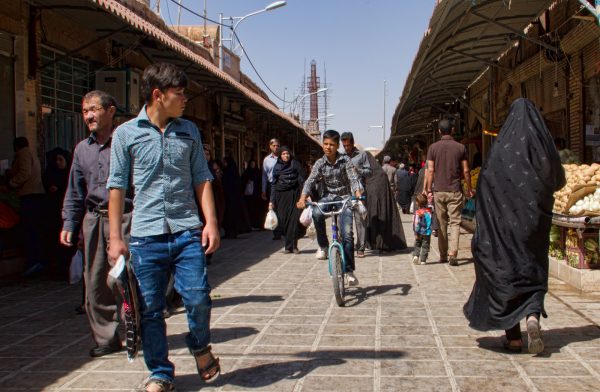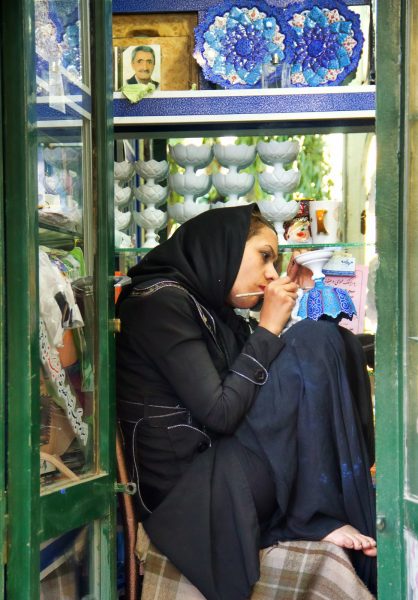On the Road is a weekday feature spotlighting reader photo submissions.
From the exotic to the familiar, whether you’re traveling or in your own backyard, we would love to see the world through your eyes.
Good Morning All,
Hey, guess what – more out-of-sequence pictures. These predate some others that ran recently, so sorry arrieve. I sometimes do things as drafts, and sometimes they get buried behind more recent posts and then get forgotten. You’re not the only victim, more great pictures and apologies are coming next week.
Have a wonderful day, everybody – and enjoy the pictures!
Today, pictures from valued commenter arrieve.
Iran, Part 3. Some pictures of the people.
Taken on April 2015
Tehran
This is how a lot of the Tehran women dress — a manteau that could pass for a chic coat in Europe, colorful headscarf, fashionable accessories. You don’t see much of this in the south, where women mostly dress in black full-length chadors.
I definitely felt very dowdy in Tehran — in my version of a manteau, I looked like I had just come in from milking the cows.
Taken on April 2015
Yazd
A teenage boy sent to pick up the bread in Yazd.
Taken on April 2015
Kerman
Caught you looking! The bazaar in Kerman.
Taken on April 2015
Isfahan
Painting some of the ceramics for sale in Isfahan. I love her bare feet!
Taken on April 2015
Tehran
I met these girls outside a museum in Tehran, where they were on a school trip. They noticed my camera, so I asked if I could take their picture and as you can see, they were very reluctant!
Iran, Part 4
Taken on April 2015
Tehran
This is the interior of the palace where the last shah lived before the revolution. I found it interesting that it was basically just kept as it was — all the fancy, truly hideous furniture, and expensive gifts from world leaders, and the empress’s many gowns — and turned into a museum. It’s far from the most ostentatious palace I saw in Iran; the Qajar dynasty had a fondness for covering every single surface with mirrored glass, sometimes to beautiful effect, but mostly not. But apparently no one wanted to live in the shah’s palace or take any of his fancy stuff. They just made him history.
Taken on April 2015
Persepolis
I took this picture from one of the palaces at Persepolis. These tent poles and the trees that surround them were planted in 1971 for a grand celebration of the 2500th anniversary of the founding of the Persian Empire by Cyrus the Great. Kings and queens and presidents and prime ministers from around the world feasted on caviar and quail eggs and roast peacock stuffed with foie gras before retiring to the luxury apartments, complete with marble bathrooms, inside their tents.
It was a grand success on the international social calendar and a disaster domestically. Few Iranians were invited to the festivities, and there was widespread criticism of the enormous costs involved. Eight years later the shah was gone, and the tents have been rotting in the desert ever since.
Taken on April 2015
Tehran
The two-room house where the Ayatollah Khomeini lived in Tehran is a short drive from the shah’s palace, and a world away. There is nothing glamorous about it; it’s barely comfortable. But he obviously wasn’t interested in worldly goods; there are photos of him meeting with world leaders on that sheet-draped couch.
I think it’s impossible for an American not to have a complicated response to Khomeini, but he is very much revered in Iran. He is always called Imam Khomeini, rather than Ayatollah Khomeini, — where “Ayatollah” just means a high-ranking Shia cleric, “Imam” is more like being the Pope, a true successor of the Prophet. His picture glowers down on every public space.
Taken on April 2015
Tehran
This painting was in one of the smaller palaces in the Niavaran complex which the shah used for entertaining. I’d always thought Muslims didn’t allow art that depicted people, but there are many paintings in the Tehran museums that do, although mostly from the 19th century or before. Much more shocking: one of the museums even had a painting of Mohammed. When we asked our guide about it — isn’t it forbidden to portray the Prophet? — she just shrugged. “That’s a Sunni thing.”
Taken on April 2015
Tehran
(Sorry got these out of order — meant to put this with the other Khomeini picture.)
The entrance to the Khomeini compound. I wanted to take a picture of the sign and was waiting for the guard to get out of the way. Instead he came over and told me, very nicely, that photography wasn’t allowed — I hadn’t noticed the small sign on the wall behind him. But he didn’t make me delete the picture, which is better with him in it anyway.
Thank you so much arrieve, do send us more when you can.
Travel safely everybody, and do share some stories in the comments, even if you’re joining the conversation late. Many folks confide that they go back and read old threads, one reason these are available on the Quick Links menu.
One again, to submit pictures: Use the Form











Mary G
Fascinating. Love the chic lady and the barefoot pottery painter!
JPL
The pictures really do tell a story. Thank you so much for sharing tales about your travels.
Amir Khalid
The title Imam means quite different things to Sunnis (like me) and to Shiites.
Per Wikipedia:
p.a.
Nice shots, and very informative. Thanks!
Cermet
There are a lot of Muslim laws that have no bases in the Qur’an but none-the-less, like in Christianity, are considered part of their religious ‘rules’. I believe that for them (as for Judaism), the only forbidden image one cannot make, from the commandments, is one of god.
OzarkHillbilly
I’d love to go to Iran someday.
arrieve
@OzarkHillbilly: I’d love to go back. It was a fascinating country, the food was delicious, the people were very friendly and welcoming, and I only saw a small part of it in two weeks. I think this is the last of my submissions, but when I get a chance I’ll put together some more pictures of mosques and tombs.
Starfish
@arrieve: I am rarely in the photo threads at all. They do not speak to me, but all these photos of Iran make me miss my family. I have family in both Tehran and Isfahan.
@Cemet: Are you commenting about there being images of people here? Iranians have historically been more likely to draw people than the other Muslim countries. Someone, who had been to a mosque once, came to my mother’s house and was critical that we had family photos. So rude!
Cemet
@Starfish: Sorry, I was not generalizing to people and images. Relative to my comment, as I understand from my readings, only rendering an image of god is forbidden, not images of people (nor, then the Prophet, I’d assume from logic but that is a dangerous assumption when it comes to religious rules.) I can’t really recall any Islamic rule against images of people but certainly, local customs vary among all peoples/religion I’d guess.
Barbara
@Cemet: Hmm. I thought it extended to images of people, but of course it probably varies and once photographs came into being, it’s impossible to see how it could be strictly enforced. Whatever the rules are, those are great pictures.
susanna
Terrific pictures of Iran’s people, and thanks for the descriptive remarks. It appears to me that one can easily find ‘jewels’ throughout the country and in many forms.
Steve in the ATL
@Amir Khalid:
So does this mean you are or aren’t a terrorist? Shiites are located in countries such as Iran and Iraq that never attacked us but are our worst enemies, while Sunnis are in countries such as Saudi Arabia that have attacked us yet are considered our BFFs.
Bigotry, lies, and ignorance can be so confusing!
Doug
Is it not passing brave to be a king
And ride in triumph through Persepolis?
J R in WV
@Starfish:
A wonderful sharp remark, concealed in an off-hand remark. Well done!!! So deep, in just those eight words.
J R in WV
@arrieve:
And thanks so much for these fine photos of ordinary people living decent lives in a normal fashion, yet surrounded by fabulous remnants of a past yet vast empire.
Starfish
@Cemet: No offense taken about what you said. There are workarounds to all the rules, and they are beautiful. Google “Islamic calligraphy drawings.”